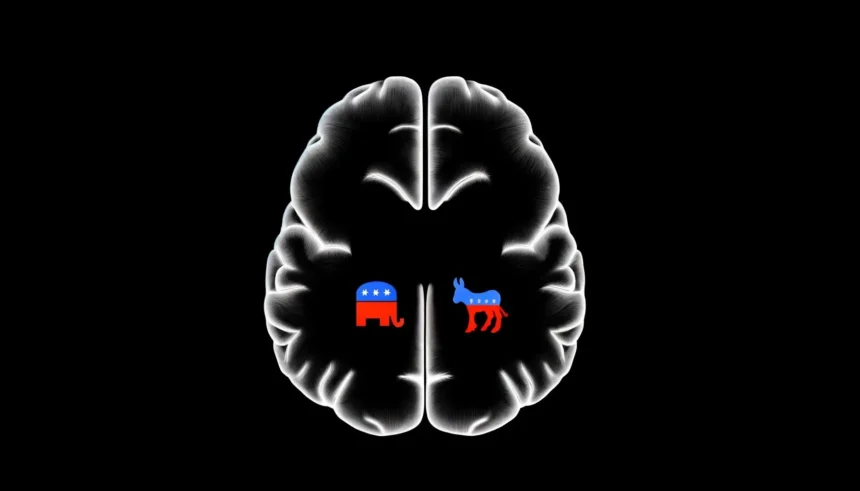In “The Political Brain: The Emergence of Neuropolitics,” Matt Qvortrup presents an innovative framework that combines neuroscience with political science to understand how neural processes influence political decisions and behaviors. Utilizing a mix of empirical evidence and robust theories, Qvortrup reveals the profound impact of these processes on political actions. His work connects complex neuroscience concepts with practical political phenomena, making his book essential reading for academics, professionals, and the public.
Written with intellectual passion, the book stands out for its interdisciplinary approach, showcasing how neuroscience can enhance our understanding of electoral behaviors and campaign strategies. It emphasizes the importance of considering non-traditional methods in political analysis, opening new theoretical and practical perspectives for future research. Qvortrup’s ability to translate complex technical concepts into accessible language also makes it valuable for those without a specialized background in neuroscience or political science.
The integration of history and philosophy with modern scientific advancements offers a rich and comprehensive perspective on the development of neuropolitics.
Qvortrup highlights how advances in brain imaging technology, such as functional magnetic resonance imaging (fMRI), have enabled scientists to observe brain activity in real-time. This has opened new possibilities for investigating how emotional and cognitive processes influence political decisions. Through detailed studies and practical examples, Qvortrup shows how integrating neuroscience into political science can provide a more comprehensive and nuanced understanding of human behavior in political contexts.
History and Philosophy of Neuropolitics
The first chapter offers a detailed review of the historical and philosophical evolution of our understanding of the brain and its implications for political science. Qvortrup explores the theories of ancient philosophers like Plato and Aristotle, who posited that human behavior is driven by a combination of reason and emotion. This discussion extends through time, highlighting how the Enlightenment and scientific advancements shifted the focus toward a more empirical understanding of the brain.
The book examines the neuroscientific basis of group identity and political polarization.
The author examines the contributions of key figures such as René Descartes, John Locke, Franz Joseph Gall, and Santiago Ramón y Cajal. Descartes proposed the dualistic separation of mind and body, while Locke emphasized the importance of sensory experience. Gall developed phrenology, while the Spanish physician and scientist Ramón y Cajal laid the foundations for modern neuroscience with his neuronal theory. Qvortrup explains how these theories evolved with the advent of technologies like fMRI, allowing scientists to observe brain activity in real-time and link specific neural processes with political behaviors.
This chapter underscores the importance of a multidisciplinary approach, combining knowledge from neuroscience, psychology, and political science to provide a deeper understanding of political behavior. In doing so, Qvortrup lays the groundwork for a nuanced exploration of how the brain shapes politics, setting the stage for subsequent chapters to expand on this foundational knowledge. The integration of history and philosophy with modern scientific advancements offers a rich and comprehensive perspective on the development of neuropolitics.
Group Identity and Polarization
The book examines the neuroscientific basis of group identity and political polarization. It analyzes how the amygdala, responsible for processing emotions like fear and aggression, becomes more active when individuals are exposed to members of out-groups.
This discovery explains the effectiveness of divisive political rhetoric. Qvortrup presents studies showing that amygdala activity is more pronounced when viewing unfamiliar faces from out-groups, reinforcing “us versus them” mentalities.
However, he also provides evidence that familiarity with out-group members can reduce this bias. He emphasizes that greater exposure to diverse groups can lead to increased empathy and a reduced amygdala response.
This finding highlights the importance of social integration and inclusive policies to mitigate political polarization. Research shows that attitudes toward out-groups can change with exposure and interaction, suggesting that education and inclusion policies can play a crucial role in reducing polarization.
Education and inclusion policies can play a crucial role in reducing polarization.
Furthermore, the author explores how socioeconomic factors influence political attitudes. People in economically disadvantaged areas are more susceptible to fear-based messages from populist leaders, a susceptibility linked to the brain’s response to perceived threats, exacerbated by economic insecurity and social exclusion.
Qvortrup provides a detailed analysis of how the brain shapes politics through group identity and polarization, offering valuable insights into the neurological foundations of contemporary political phenomena.
Emotions in Elections: Neuroscientific Insights
Qvortrup examines how social neuroscience provides insights into political attitudes and behaviors during election campaigns. He discusses how brain imaging techniques, such as fMRI, have revolutionized our understanding of voter behavior, particularly the role of the amygdala and its activation in response to emotional stimuli. This neural activity explains why emotionally resonant messages often have a greater impact than purely factual ones.
The book explores the applications of neuropolitics to improve democratic processes, focusing on the mechanisms of listening and empathy.
The concept of “neuromarketing” is explored, showing how political strategists use neuroscientific principles to design messages that deeply resonate with voters’ emotions. By understanding which brain regions are activated by certain types of political messages, campaigns can tailor their strategies to trigger desired responses, enhancing their persuasive power. This approach allows for predicting voter preferences with surprising accuracy, using data on emotional responses to adjust strategies in real-time.
Qvortrup also addresses how unconscious biases influence political attitudes. He presents evidence that certain brain patterns are associated with conservative or liberal ideologies, emphasizing that our political inclinations may be deeply rooted in our neural architecture. This analysis reveals how emotions and unconscious biases shape political behavior, providing a nuanced understanding of electoral dynamics and emphasizing the role of emotional engagement in the democratic process.
Listening and Empathy in Democracy
The book explores the applications of neuropolitics to improve democratic processes, focusing on the mechanisms of listening and empathy. Qvortrup examines the neural basis of listening and its crucial role in political deliberation, highlighting the dorsolateral prefrontal cortex’s involvement in rational deliberation and decision-making. He argues that enhancing these neural pathways through deliberate practice can improve the quality of political discourse.
Fostering cognitive flexibility can make political systems more resilient and responsive.
He emphasizes the importance of empathy in politics, based on studies showing how empathy is rooted in specific brain regions.
Qvortrup presents evidence that political leaders with higher levels of empathy are more effective in building consensus and navigating complex social issues.
He suggests that fostering empathy through targeted interventions could enhance the democratic process, promoting greater cooperation and understanding among different political groups.
Additionally, he discusses cognitive flexibility, linked to neural circuits in the prefrontal cortex, and how it can be cultivated to promote open-mindedness in political leaders. Qvortrup believes that fostering cognitive flexibility can make political systems more resilient and responsive. Combining these skills can strengthen leaders’ ability to make informed and balanced decisions, contributing to more effective and ethical governance.
The Future of Neuropolitics
In the epilogue, Qvortrup reflects on the current state and potential future of neuropolitics. Although the field is still developing, it has already provided valuable insights into political behavior. The transformative potential of neuropolitics suggests that continued interdisciplinary collaboration could lead to a deeper and more comprehensive understanding of political dynamics. This perspective highlights the importance of combining neuroscience, psychology, and political science to create a holistic view of how brains shape politics.

Qvortrup emphasizes that true advancement in neuropolitics will come from integrating diverse scientific disciplines. Combining tools and approaches from neuroscience with traditional political science methods can offer new ways to analyze and understand political behavior. The incorporation of techniques like fMRI and EEG can reveal the underlying processes in decision-making and attitude formation, providing a window into the brain’s inner workings during critical political situations.
Qvortrup’s interdisciplinary approach offers new perspectives on political behavior and decision-making.
Moreover, Qvortrup addresses the limitations and ethical considerations of neuropolitics. He stresses the need for responsible use of neuroscientific tools and warns against potential misuse, such as manipulating voter behavior through targeted neuromarketing. It is crucial to establish regulations and ethical frameworks to guide the application of neuroscience in the political realm. Transparency and ethics must be fundamental principles to ensure that advances in neuropolitics benefit society as a whole and are not used to undermine democratic processes.
Qvortrup also explores how neuropolitics can contribute to improving the quality of democracy. By better understanding the neural mechanisms behind empathy and deliberation, it is possible to design interventions that foster greater understanding and cooperation among different political groups. Training in deliberative skills and promoting empathy through educational programs could strengthen the democratic fabric, making citizens and political leaders more receptive and understanding of others’ perspectives.
Looking to the future, Qvortrup envisions a scenario where neuropolitics plays a central role in political analysis and practice. As the field matures, it could provide robust frameworks for understanding complex political phenomena, from the rise of populism to the mechanisms of political persuasion. This integrated approach could also address global issues such as climate change, social justice, and world peace, offering solutions based on a deeper understanding of human nature.
Conclusion: The Impact of Neuroscience on Political Understanding
“The Political Brain: The Emergence of Neuropolitics” by Matt Qvortrup is a comprehensive exploration of how brains shape politics. Qvortrup’s interdisciplinary approach offers new perspectives on political behavior and decision-making, demonstrating how understanding the brain can impact political analysis, campaign strategies, and governance. His ability to translate technical concepts into accessible language makes it valuable for both academics and the general public.
Qvortrup highlights that integrating neuroscientific principles into political science provides deep insights into voter behavior and leadership qualities. The book examines the neural mechanisms behind emotional responses, group identity, and cognitive flexibility, revealing how these factors influence political dynamics. This understanding is crucial for developing more effective political strategies and fostering a more empathetic and inclusive political environment.
A key contribution of the book is its emphasis on the practical applications of neuropolitics. Qvortrup shows how neuroscientific insights can improve democratic processes and optimize political communication. He advocates for the responsible and ethical use of neuroscience in politics to benefit society.
“The Political Brain” stands out as a significant work in political science, providing a framework for understanding the interaction between brain functions and political behavior.









